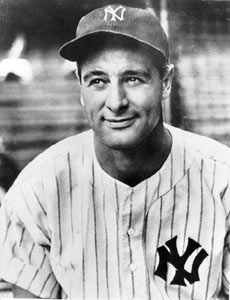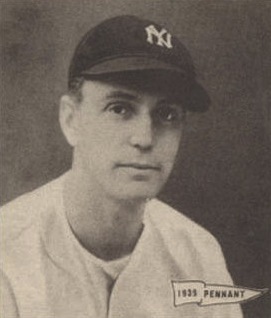May 2, 1939: Lou Gehrig’s streak ends in Detroit
 Detroit’s Briggs Stadium, renamed after 1935 for new owner Walter Briggs, was a roomy ballpark by 1939 standards. Taking over 23,000-seat Navin Field, which had opened in 1912, Briggs had expanded capacity to over 50,000 in 1938. In response, the Tigers drew 10,121 per game, second in the American League, as the country climbed out of the Depression and Detroit finished 84-70. On this Tuesday afternoon, 11,379 came out to see their hometown team in an early season battle with the mighty Yankees.
Detroit’s Briggs Stadium, renamed after 1935 for new owner Walter Briggs, was a roomy ballpark by 1939 standards. Taking over 23,000-seat Navin Field, which had opened in 1912, Briggs had expanded capacity to over 50,000 in 1938. In response, the Tigers drew 10,121 per game, second in the American League, as the country climbed out of the Depression and Detroit finished 84-70. On this Tuesday afternoon, 11,379 came out to see their hometown team in an early season battle with the mighty Yankees.
Since winning the American League pennant and World Series in 1935, the Tigers had won 83, 89, and 84 games over the next three seasons. While the likes of Hank Greenberg, Charlie Gehringer and Rudy York continued to score runs freely, the pitching staff was allowing them in bunches; the pitchers finished in the lower half in AL earned run average over 1936-38. In 1939 the Detroit fans were looking for improved pitching — particularly to a return to form by ace Tommy Bridges, and a healthy Schoolboy Rowe.
The Yankees, on the other hand, had rolled along in fine fashion. The Bronx Bombers won the 1936, 1937, and 1938 American League pennants and World Series and were primed for more success with a continued influx of young talent to complement skilled veterans.
After the games played on May 1, the Yankees were tied for first place with Boston (5-3) and Chicago (6-4); the Tigers and Washington were just a half game behind. Yankee ace Red Ruffing, coming off of three consecutive 20-win seasons and off to a good start (2-0, 1.29 ERA) was going up against sinkerballing1 right-hander Vern Kennedy (0-1, 4.26 ERA). Despite a tendency to struggle with control, Kennedy had been an American League All-Star in 1936 and 1938.
The Yankees had scored only 29 runs in their first eight games, tied for last in the American League. Frankie Crosetti was hitting .147; Lou Gehrig, with a career average of .340 over 17 seasons, was at .143; and George Selkirk, .214. The New Yorkers, though, were bolstered by a pitching staff that was clearly the class of the league, allowing fewer than three runs a game.
The chatter in New York, and throughout baseball, was the 36-year-old Gehrig’s greatly diminished performance. Was it age? Was is the wear and tear of playing in every Yankee game since June 1, 1925? Lou consistently rebutted and pushed back, saying, “I have given my best to the club and the game and I deserve the chance to work out my current difficulties.”2 Compounding Yankee fans’ anxiety was the health of young All-Star outfielder Joe DiMaggio; he had been hospitalized with a foot injury sustained on April 29 and was projected for an extended recuperation.
As fans filed in hoping to see their Tigers take one from the vaunted Bronx Bombers, most didn’t realize that something historic had already happened — in the lobby of the Book-Cadillac Hotel that morning, well before game time. Frustrated with his performance on the year and the inability to play up to his high self-imposed standards, Gehrig had approached manager Joe McCarthy and stated his desire to bench himself, ending his consecutive game streak at 2,130, by far the major league standard.3
“I told him it would be as he wished. Like everybody else I’m sorry to see it happen. I told him not to worry. Maybe the warm weather will bring him around. We’ll miss him. You can’t escape that fact. But I think he’s doing the proper thing,”4 McCarthy told reporters later.
After McCarthy made his announcement, Gehrig himself spoke with reporters and confirmed his decision and the rationale. “I haven’t been a bit of good to the team since the season started.”5 He expressed his desire to be fair to his teammates and his gratitude to manager Joe McCarthy for ongoing support.
Babe Dahlgren took Gehrig’s place at first base. Dahlgren, 27, was no stranger to durability, having played in 563 games from 1932 through 1934 with the Mission Reds of the extended-season Pacific Coast League. Dahlgren had debuted with the Red Sox in 1935 against Gehrig and the Yankees. He spent most of the 1936 season in the minors before the Yankees purchased his contract during 1937 spring training.
 Manager McCarthy asked Gehrig to carry the pregame lineup card to home plate. At that point, Tiger radio announcer Ty Tyson informed the crowd that Gehrig was pulling himself from the lineup, ending his streak. The news at first was greeted with stunned silence, then a “deafening cheer.”6 Gehrig tipped his cap to the fans in appreciation while trying to keep his composure.
Manager McCarthy asked Gehrig to carry the pregame lineup card to home plate. At that point, Tiger radio announcer Ty Tyson informed the crowd that Gehrig was pulling himself from the lineup, ending his streak. The news at first was greeted with stunned silence, then a “deafening cheer.”6 Gehrig tipped his cap to the fans in appreciation while trying to keep his composure.
The game itself, almost an afterthought, became a laugher early, as the Yanks chased Kennedy in the first inning with six runs. They had four homers overall, including one by Dahlgren, and ran away with a 22-2 victory in an economical 2 hours and 22 minutes.
Gehrig spent the game on the bench, an unaccustomed place, struggling, by multiple accounts, with the emotions of the day7. Dahlgren went to him late in the game, attempting to convince him to take over first base and keep the streak going.8 Gehrig declined, and Dahlgren recalled in a 1989 interview, “He had made up his mind.”9
Prior to the game, Gehrig had announced his intention to sit “a couple of games” and assess how he felt afterwards.10 He expressed hope that the coming warm weather would help him regain his strength. The thought was perhaps that where hard work and practice didn’t improve his performance, rest would.
But after the game, Gehrig’s status was uncertain. The New York Daily News ran a photo the next day of Lou on the dugout steps with the caption “End of the Road?”11 DiMaggio was seriously injured with no firm date for return. How would the Yankees respond with perhaps their two best players of recent years absent from the lineup? The champions had a look of seeming vulnerability. Would 1939 be another championship season, or reminiscent of 1933-35 disappointments when New York had finished in second place?
Indeed, this early-season blowout victory, while welcome, was likely not of real comfort to many loyal Yankee rooters.12
Sources
Eig, Jonathan. Luckiest Man. (New York: Simon and Shuster, 2005), 288-291.
James, Bill and Rob Neyer. The Neyer/James Guide to Pitchers. (New York: Fireside, 2004), 264.
Robinson, Ray. Iron Horse: Lou Gehrig in His Time. (New York: HarperPerennial, 1990), 257.
Daniel, Dan. “Withdrawal of Gehrig, DiMag Injury Jar Yanks.” The Sporting News, May 4, 1939.
Dawson, James. “Gehrig Voluntarily Ends Streak at 2,130 Straight Games.” New York Times, May 3, 1939.
Salsinger, H. G. “Detroit’s Infield Gains in Hit-Crop that Garden Lacks: Rowe’s Comeback Promise Brightens Mound Outlook.” The Sporting News, April 6, 1939.
“Adds to Rosy Hue of Red Sox.” The Sporting News, April 11, 1935.
New York Daily News, May 3, 1939.
YouTube.com, Babe Dahlgren interview, 1989 (Accessed August 22, 2014 ).
Baseball-Reference.com
Retrosheet.org
Notes
1 James and Neyer, The Neyer/James Guide to Pitchers, 264.
2 Daniel, The Sporting News, May 4, 1939.
3 Fourteen years after being replaced by Gehrig in the Yankee lineup, western Michigan native Wally Pipp was in the lobby of the Book-Cadillac Hotel while on a business trip when word started circulating about the end of the streak (Dawson, “Gehrig Voluntarily Ends Streak at 2,130 Games”). Pipp attended the game that afternoon and commented to reporters that “Lou looks ill to me” (Eig, Luckiest Man, 290).
4 Dawson.
5 Eig, 288.
6 Dawson.
7 YouTube.com, Dahlgren interview.
8 Eig, 290.
9 YouTube.com, Dahlgren interview.
10 Eig, 288.
11 New York Daily News, May 3, 1939.
12 While the season may have looked in doubt at that point, the Yankees and DiMaggio recovered, winning 106 games in the regular season and sweeping Cincinnati in the World Series. DiMaggio returned to the regular lineup in June and ended up winning the American League batting title and MVP award with a .381 batting average, 30 home runs, and 126 RBIs in only 120 games. Dahlgren hit a modest .235 in 144 games but drove in 89 runs. (Baseball-Reference.com). The only game Gehrig ever played in again was a Yankee exhibition game on June 12 against the Kansas City Blues, one of the club’s top farm teams. He grounded out and struggled mightily in the field (Robinson, Iron Horse, 257). Dahlgren became the regular first baseman the rest of that season and through 1941. (Baseball-Reference.com).
Additional Stats
New York Yankees 22
Detroit Tigers 2
Briggs Stadium
Detroit, MI
Box Score + PBP:
Corrections? Additions?
If you can help us improve this game story, contact us.

